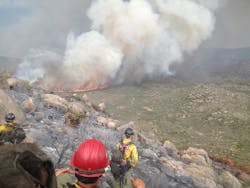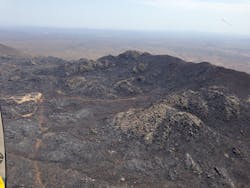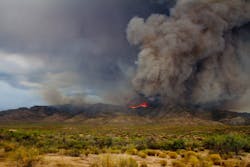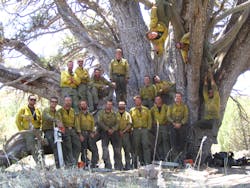On June 30, 2013, 19 members of the Granite Mountain Interagency Hotshot Crew (IHC) were entrapped and lost their lives on the Yarnell Hill Fire in Arizona. In the fire service, we honor our fallen by learning from them. With the five-year anniversary approaching, this is a good time to ask a question: How have we learned from this accident?
The incident
Late afternoon on June 28, the Yarnell Hill Fire started on a remote ridgetop west of Yarnell, AZ. Located in a boulder field in steep terrain, the fire showed little activity or spread potential. The incident commander (IC) prepared for full suppression on the following morning.
On June 29, firefighters held the fire in check until around 4 p.m., when winds increased and the fire spotted outside containment lines. That evening, the Type 4 IC ordered a Type 2 incident management team (IMT) and additional resources.
By the morning of June 30, the fire had grown to approximately 300–500 acres. In a 7 a.m. briefing, the incoming Granite Mountain IHC superintendent accepted the role of Division Alpha Supervisor. His assignment was to establish an anchor point at the heel of the fire.
For most of the day, the fire spread to the northeast, threatening structures in Model Creek and Peeples Valley. Around 3:50 p.m., the wind shifted and the fire started pushing aggressively to the southeast, toward Yarnell.
Fire resources shifted to resident evacuation and structure protection in town. Only the Granite Mountain IHC remained out on the ridge, on the southwest perimeter of the fire. Personnel who communicated with the Granite Mountain IHC knew the crew was using the black as a safety zone at the southwest end of the fire—and believed they would stay there. When the crew said they were moving, they were not fully understood.
Sometime after 4:04 p.m., the crew left the black and headed for the town of Yarnell. They were hiking through an unburned box canyon when the wind shifted again. At 4:30 p.m., thunderstorm outflows reached the southern perimeter of the fire, driving the fire directly south. The fire overran the Granite Mountain IHC at about 4:42 p.m.
Gaps in our knowledge
With that said, following are some approximate timeframes:
- 7 a.m.–3:45 p.m.: The crew arrived at the fire and attended a briefing. They worked near the heel of the fire, on the edge of the black, which was their safety zone.
- 3:45–3:55 p.m.: The crew heard about and then experienced a wind shift that caused the fire to change direction. Other resources were relocating to Yarnell.
- 3:55–4:04 p.m.: The crew hunkered in the black and discussed their options.
- 4:04–4:20 p.m.: The crew left the black, hiking south along a two-track road near the ridgetop.
- 4:20–4:39 p.m.: The crew descended from the two-track road into an unburned box canyon. They were heading directly for a ranch (a safety zone) on the edge of town.
- 4:39 p.m.: Realizing they were entrapped, the crew called for help and prepared to deploy fire shelters. The fire overran them soon after.
For deeper detail, read the Yarnell Hill Fire Serious Accident Investigation Report (2013) or the Yarnell Hill Fire Case Study (2014), both available at firelinefactors.com/resources.
Crew learning exercises
In the fire service, we learn from our accidents. Over our history, we have gotten better at fighting fire, and we’ve gotten better at learning. Many believe we have not learned enough from this accident. One reason is we don’t fully understand the events of June 30, 2013. It can be hard to see what the lessons are, and how to improve for the future.
Following are exercises I’ve found useful in training sessions and workshops. They can be good discussion tools for your crew as well.
Exercise 1: We don’t know for certain why the crew left the black. But we can learn a lot by trying to put ourselves in that scenario, and asking what could motivate us to do the same thing. Sometimes people react to this exercise by simply stating that they would not make the same decision. That may be true, but can you remember when you’ve done this sort of thing before? Or when you have seen it? The point is to relate to the natural human motivations that drove them. We have the same drives; they sometimes lead us to success, and sometimes into trouble. The better we know our own human instincts, the better leaders and decision-makers we can become. One of the Wildland Fire Leadership Principles is, “Know yourself and seek improvement.” With this in mind, you can use this question as a tool: “If we were safe in the black, what might motivate us to leave?”
Exercise 2: After Granite Mountain left the black, they hiked on a two-track road for about 15 minutes. Then they left the road and hiked down into an unburned box canyon, taking the most direct route to a ranch on the edge of town. Prior to this, the crew had options: They could return to the black or take a number of other routes. As they hiked down into the canyon, their options disappeared. In hindsight, we know the outcome. At the time, however, this path must have made sense to them. It must have felt better than their other options.
Humans are not completely objective. We are influenced by social, political and emotional factors. We don’t pay much attention to how such factors affect us, so they can push us and pull us without our knowing. Think what it may have been like if you were with the crew, hiking through the canyon. And with this in mind, ask yourself: “If we were there, why would that path feel right to us?”
Exercise 3: Trying to take the crew’s perspective (or at least imagine it) is a powerful learning exercise. Their perspective matters because we are trying to develop ourselves for when we may be in similar situations. Their actions must have made sense to them, based on their expectations. We can be sure they did not expect the outcome they faced. When has a fire caught you off guard? To try to get a sense for their decision-making, ask yourself: “How were they expecting this to turn out?”
Respect for the past, learn for the future
You will get more out of these exercises by comparing notes with other firefighters. You might be surprised at what they come up with. And it’s better to be surprised in the training room or at the dinner table rather than on a fire.
The most important point about learning is why we do it—and who we are doing it for. These are not academic exercises. The purpose of these exercises is to help you make yourself stronger and more effective for the future. And the reason we do that is for our pride in our own performance, and the men and women who we work shoulder to shoulder with, the public we swore to serve, and the people who need us to come home.
We can’t change the past or what happened to their crew. But if we respect the past, we can use it to develop our crew for the future. We may not know exactly how they chose their path, but we can see ourselves on a similar path, then learn from it. As firefighters, the best way to honor the fallen is to respect the past and learn for the future. What we do with our performance and our crew is the most meaningful memorial we can build.
Sidebar: Remembering the Fallen
· Andrew Ashcraft, 29
· Robert Caldwell, 23
· Travis Carter, 31
· Dustin DeFord, 24
· Christopher MacKenzie, 30
· Eric Marsh, 43
· Grant McKee, 21
· Sean Misner, 26
· Scott Norris, 28
· Wade Parker, 22
· John Percin, Jr., 24
· Anthony Rose, 23
· Jesse Steed, 36
· Joe Thurston, 32
· Travis Turbyfill, 27
· William Warneke, 25
· Clayton Whitted, 28
· Kevin Woyjeck, 21
· Garret Zuppiger, 27
About the Author
Brad Mayhew
Brad Mayhew is the founder of Fireline Factors Consulting (firelinefactors.com). He has been writing, training and consulting on risk and resilience in fire for over a decade. Mayhew has a master’s degree in Human Factors and System Safety, and serves on investigation teams, including Yarnell Hill (2013) and Coal Canyon (2011). His roles include lead investigator, human factors specialist, training products developer, and investigation process consultant. He served on the USFS Los Padres Hotshot Crew (Santa Barbara, CA) and authored the IRPG’s Human Factors section. He received the NWCG Paul Gleason Leadership Award for Innovation.



